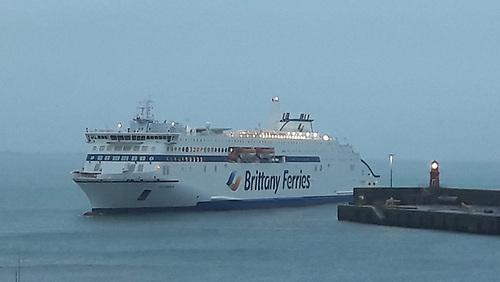Brittany Ferries is to open another new direct Ireland-Spain route, albeit based on a ‘winter-only’ basis between Rosslare and Santander in northern Spain, writes Jehan Ashmore.
The new temporary service which was announced in recent months to Santander will operate from 7 November 2023 to 22 March 2024 as the Rosslare-Bilbao route launched in 2020 will not be operating during this period so to facilitate port infrastructure at the Bilbao (Santurtzi) terminal.
Sailings on the new Ireland-Iberian winter 2023/24 route will see crossings from Rosslare depart on Tuesday mornings and Friday evenings and with all sailings involving at least one night on board or two-night sailing direct to Spain. Rosslare to Santander sailings times will range from 27 hours 45 minutes to 31 hours (and in the opposite direction) between 28 hours to 33 hours.
Afloat has consulted the sailing schedule in which the first outbound sailing from Rosslare to Santander takes place on Tuesday, 7 November and the final sailing from Spain to Rosslare is on Friday, 22 March, 2024. In total there will be 37 sailings from Ireland.
The inaugural sailing from Rosslare, Afloat adds will be rostered to Salamanca, a cruise ferry from the E-Flexer series powered by cleaner liquefied natural gas (LNG) emitting less CO2 (carbon dioxide) emissions. Another E-Flexer, Santoña has been assigned to operating Ireland to Spain sailings on the Friday evenings.
A third E-Flexer, Galicia will also in 2024 be operating between Ireland and Spain.
Santander which is the capital of Cantabria, was previously linked with Brittany Ferries which notably launched the first ever direct Ireland-Spain passenger ferry route of Cork-Santander in 2018. The Bay of Biscay route was primarily aimed at the freight market by bypassing Brexit and into Europe although it also carried holidaymakers on a no frills ‘économie’ service served by ropax’s Connemara and Kerry.
Brittany Ferries however closed the Cork-Santander route in early 2020, as the growing consensus among Irish and mainland European hauliers demanded to use Rosslare, with its proximity to Dublin and the east coast road network. They welcomed the change of the Ireland-Spain ports to that of Rosslare and Bilbao, a port also more attuned to freight traffic markets with easier transport links into the Iberian Peninsula. Since its inception the ropax operated route with limited passenger capacity has developed into cruise ferry operations due to the popularity of Irish holidaymakers heading for Spain.
In addition, Santander has had a long association with the French ferry operator when Brittany Ferries launched their first ever UK-Spain route connecting with Plymouth, Devon in 1978. The UK-Spain route currently forms part of the sailing roster of flagship Pont-Aven which also operates out of Plymouth (see story) to Roscoff and from the Breton port, the route to Cork also in the same year became Brittany Ferries first Ireland-France route.
For a second successive year, the seasonal route between Munster and Brittany, is also served by Armorique offering mid-week sailings while Pont-Aven runs a round trip at weekends.
Brittany Ferries also operate Rosslare-Cherbourg and Rosslare-Le Havre routes, the latter service between Wexford and Normandy is operated by freight ferry, Contentin (also open to passengers, but with limited cabin capacity).


























































